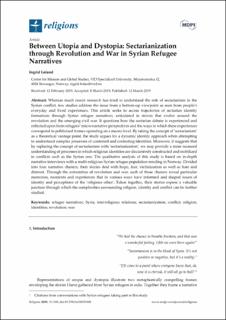| dc.description.abstract | hereas much recent research has tried to understand the role of sectarianism in the Syrian conflict, few studies address the issue from a bottom-up viewpoint as seen from people’s everyday and lived experiences. This article seeks to access trajectories of sectarian identity formations through Syrian refugee narratives, articulated in stories that evolve around the revolution and the emerging civil war. It questions how the sectarian debate is experienced and reflected upon from refugees’ micro-narrative perspectives and the ways in which these experiences correspond to politicized frames operating on a macro-level. By taking the concept of ‘sectarianism’ as a theoretical vantage point, the study argues for a dynamic identity approach when attempting to understand complex processes of contested and contesting identities. Moreover, it suggests that by replacing the concept of sectarianism with ‘sectarianization’, we may provide a more nuanced understanding of processes in which religious identities are discursively constructed and mobilized in conflicts such as the Syrian one. The qualitative analysis of this study is based on in-depth narrative interviews with a multi-religious Syrian refugee population residing in Norway. Divided into four narrative clusters, their stories deal with hope, fear, victimization as well as hate and distrust. Through the extremities of revolution and war, each of these clusters reveal particular memories, moments and experiences that in various ways have informed and shaped issues of identity and perceptions of the ‘religious other’. Taken together, their stories expose a valuable juncture through which the complexities surrounding religion, identity and conflict can be further studied. | en_US |

